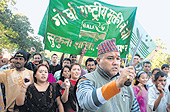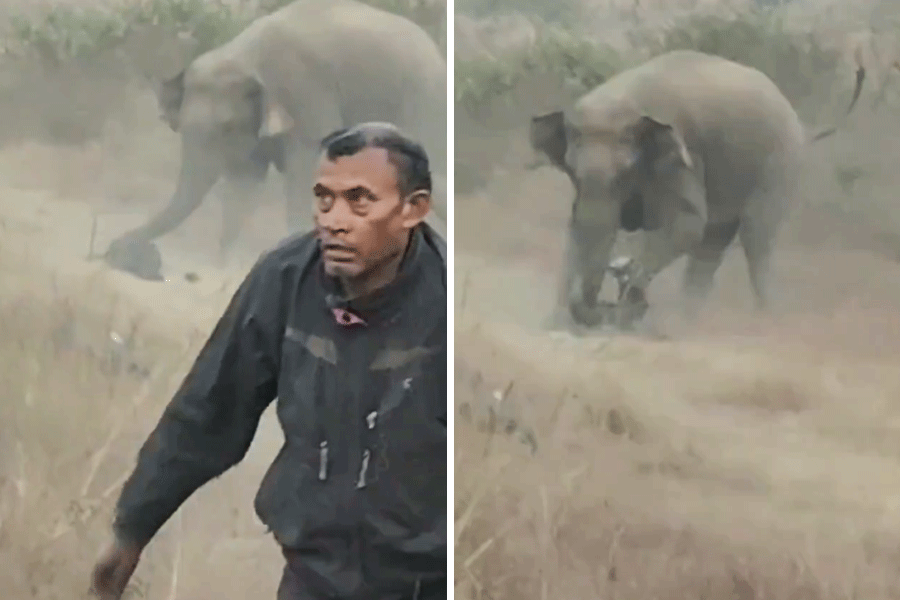 |
 |
 |
| winter of discontent: (Above) GNLF supporters agitate during the recent strike; (below) Gorkha Janmukti Morcha chief Bimal Gurung; and Subash Ghisingh. |
Bimal Gurung has done it all. As a “trusted” lieutenant of Subash Ghisingh during the violent Gorkhaland agitation of the mid-1980s, Gurung battled political opponents, ripped up roads, blocked the highway and snuffed the life out of Darjeeling. He even picked up what he says the Gorkha National Liberation Front (GNLF) boss had “taught” him to use — a gun.
Now two decades after he turned himself over to the authorities along with other GNLF activists engaged in the movement, Gurung has again taken to the streets, this time “in a more democratic fashion,” he says. Leaving the GNLF in October after “irreconcilable differences” with Ghisingh over a demand for statehood, he has floated the Gorkha Janmukti Morcha (GJM) — as much to take on his mentor as to “give birth” to Gorkhaland. This was once Ghisingh’s dream — one that he jettisoned for the Darjeeling Gorkha Hill Council (DGHC) after signing a peace accord with the state and Union governments in 1988.
As Darjeeling staggers back to life after a week of clashes and strikes, Gurung looms large over the hills, the banner of his fledgling party strung high across the main street corners in the district headquarters of Darjeeling. And Ghisingh, faced with public discontent over his failure to “deliver” as the DGHC boss and his refusal to hold elections to the body he now heads as a “caretaker” administrator, has never looked more vulnerable. “There is a strong anti-Ghisingh wave sweeping through the hills,” says lawyer Rajesh Chhetri, adding that he himself is “sick and tired of” Ghisingh’s “misrule.”
No wonder Gurung has made a flying political leap, eager to cash in on the sentiment. “He can match Ghisingh in cunning and muscle power,” says Ratna Bahadur Rai, general secretary of the Communist Party of Revolutionary Marxists (CPRM), a breakaway group of the CPI (M), which is now one of the main opposition parties in the hills. “If anyone can take on Ghisingh at the moment, it is Bimal Gurung,” says Rai.
But though Ghisingh may be down, he is not out. Politically, the GNLF still controls much of the three hill subdivisions, with its legislators from Darjeeling, Kurseong and Kalimpong. The GNLF union’s dominance in tea gardens, the only industry in the hills, is as unquestionable as its sway over the crucial transporters in Darjeeling. As if at the flick of a switch, Ghisingh choked the hill subdivisions for five days in a strike that ended on Wednesday. The strike had been called to protest an attack on K.B. Gurung, a senior GNLF leader, in Darjeeling.
Yet it is hard to miss the Gurung wave. Droves of young men spill out of the GJM office in Darjeeling’s Singmari Bazar on a recent afternoon. Inside, perched on a high-backed, towel-wrapped chair, Gurung, with a strong jaw and piercing eyes, looks as hard as nails. Wearing a camouflage jacket and trousers, he also appears battle ready.
“We did everything he asked us to do. We made him what he is today,” the 42-year-old former DGHC councillor says. “We were not born with guns. He gave us the guns and taught us how to fire them during the Gorkhaland agitation.” Gurung accuses Ghisingh of “betraying” the Gorkhas by giving up the demand for statehood.
The demand for Gorkhaland is not the main reason trouble broke out in the hills, intensifying after Gurung announced a five-day bandh from November 22, calling it off a day later after his supporters clashed with GNLF workers. Many believe that the unrest was directly related to attempts by Ghisingh — a tribal Tamang — at bringing the hill subdivision under the Sixth Schedule of the Constitution, which would give Darjeeling the status of a tribal region.
“This is not a Gorkhaland movement. It’s just an expression of people’s frustration and anger at Ghisingh and the Bengal chief minister who is backing him and is trying to impose the Sixth Schedule meant for tribal areas on Darjeeling, where tribals are in a minority,” says Madan Tamang, president of the Akhil Bharatiya Gorkha League (ABGL).
Opinions are sharply divided in Darjeeling over the bill’s “cost and benefits.” While the GNLF contends that it will give the hills more financial, legislative and executive authority, opposition parties claim it will split Nepalese-speaking society vertically into tribals and non-tribals.
The GNLF argues that bringing Darjeeling under the Schedule, in some ways, is like achieving statehood. “It will take us a step closer to realising our dream of Gorkhaland,” says Deepak Gurung, president of GNLF’s Darjeeling branch. “The DGHC will be renamed the Gorkha Hill Council. Gorkha-hill and Gorkhaland are the same thing — it’s just a matter of semantics,” he says.
The GNLF leader says the DGHC has been a little more than a “glorified” zilla parishad, with only 19 departments. “It will now go up to 45 departments,” he says. Deepak Gurung says those opposing the move are against Darjeeling’s development. “It is nothing but politics,” he says, adding that Bimal Gurung left the party as he had become “too ambitious and wanted to become the DGHC chairman.”
Asok Bhattacharya, Bengal’s municipal affairs minister and CPI (M)’s bigwig from Siliguri, says the Sixth Schedule will provide the hills with the autonomy they have been asking for. Except for the district administration, police, judiciary, state and national highways, big industry and higher education (government-run and government-sponsored colleges), every department will come under the renamed Gorkha Hill Council, Darjeeling. “They will also have the power to frame laws subject to the Governor’s approval. Darjeeling will get at least Rs 30 crore more from the Centre and Rs 10 crore more from the state once it takes effect,” Bhattacharya says.
While opposition parties in the hills are against the Sixth Schedule, not all of them agree with Bimal Gurung. “I have nothing to do with his brand of politics,” says Madan Tamang of ABGL. Rai says CPRM workers will find it hard to work with Gurung’s men, who were “with the GNLF till the other day targeting us.”
The GNLF, however, has clearly been shaken by the “desertion” of a section of youth, who have crossed over to Gurung’s GJM. In a bid to retain others, the GNLF has now revived its defunct youth front, with Ajoy Edwards, the 33-year-old managing partner of Glenarys, a chain of popular coffee shops in the hills and a hotel in Siliguri, as its convenor in Darjeeling. “The Sixth Schedule is the best thing that could happen to the hills without any drop of blood being shed and it is the closest you can get to Gorkhaland,” he says.
Bimal Gurung disagrees. Ghisingh, he believes, has “hoodwinked the people” — and he is set to “expose” him. The battle has just begun.











